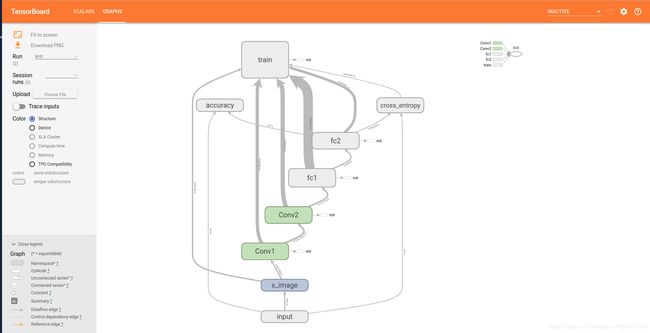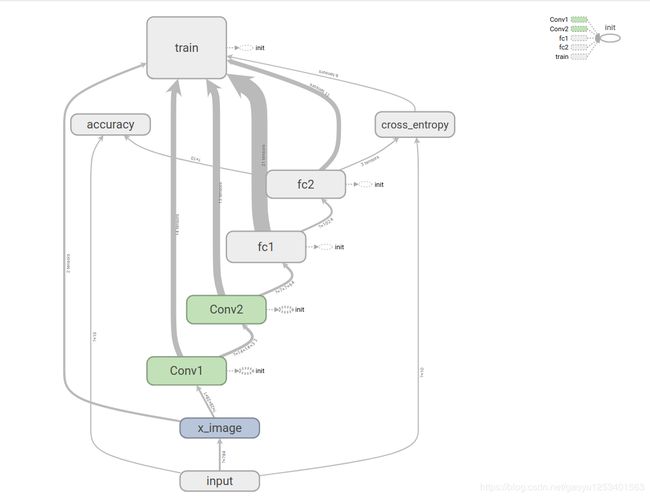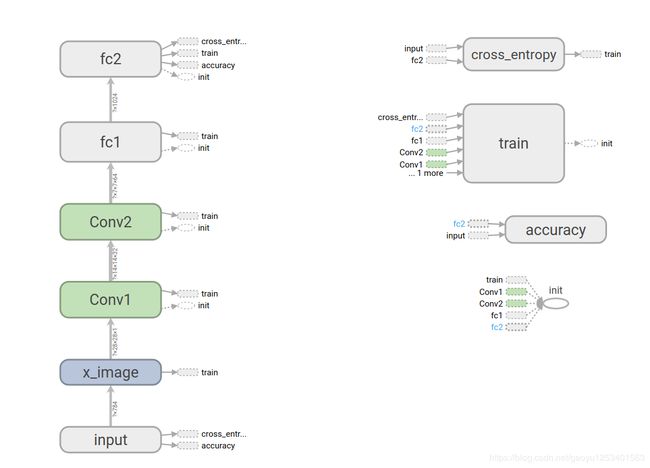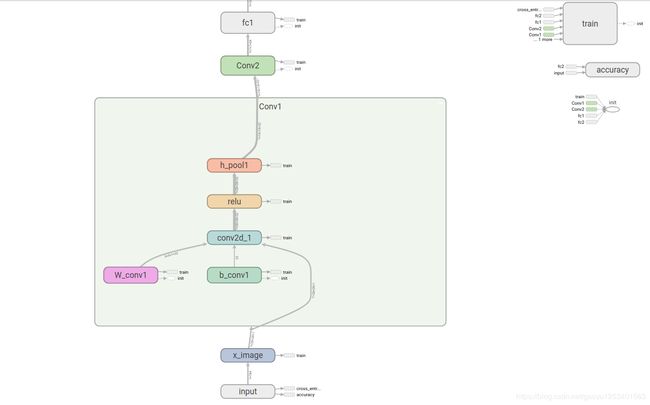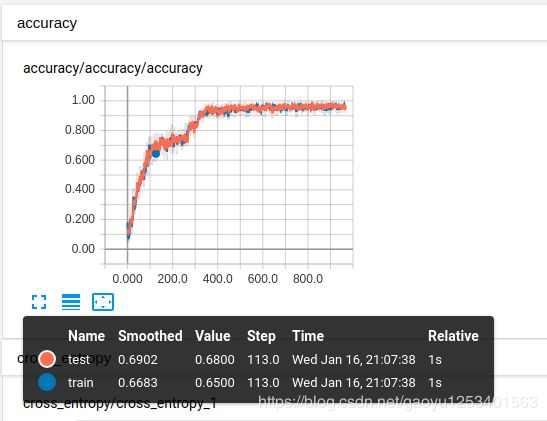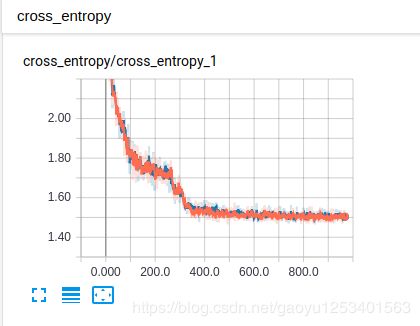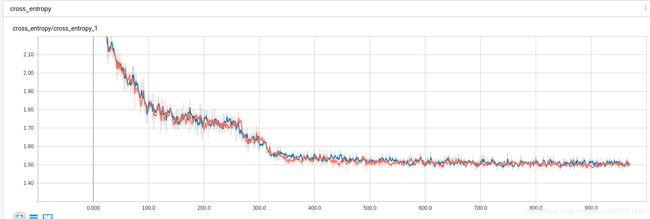Tensorflow——卷积神经网络(CNN)应用于MNIST数据集手写字体识别+Tensorboard展示
一、卷积神经网络详解
参考:https://blog.csdn.net/gaoyu1253401563/article/details/83714865
二、Tensorflow实现手写数字识别的卷积神经网络
- 编译环境:jupyter notebook
- CNN设计:输入层-卷积层-池化层-卷积层-池化层-全连接层-全连接层-输出层
import tensorflow as tf
from tensorflow.examples.tutorials.mnist import input_data
#载入数据
mnist = input_data.read_data_sets('MNIST_data', one_hot= True)
#设置批次的大小
batch_size = 100
#计算共有多少个批次
n_batch = mnist.train.num_examples // batch_size
#初始化权值
def weight_variable(shape):
initial = tf.truncated_normal(shape,stddev=0.1) #生成一个截断的正态分布
return tf.Variable(initial)
#初始化偏置
def bias_variable(shape):
initial = tf.constant(0.1,shape=shape)
return tf.Variable(initial)
#卷积层
def conv2d(x,W):
#tf.nn.conv2d()是tensorflow中实现卷积的函数
#x:需要做卷积的输入图像,四维的[batch,in_height,in_width,in_channels]
#W:filter参数,CNN中的卷积核,形状为[filter_height,filter_width,in_chnnesl,out_chnnels]
#strides:卷积时在图像每一维上的步长,这是一个一维的向量,长度为4
#padding:string类型的量,只能是“SAME”(卷积时会在外围补零)、"VALID",(不会在外围补零)这个值决定了不同的卷积方式
#结果返回一个Tensor,即我们常说的feature map
return tf.nn.conv2d(x,W,strides=[1,1,1,1],padding='SAME')
#池化层:最大池化
def max_pool_2x2(x):
return tf.nn.max_pool(x,ksize=[1,2,2,1],strides=[1,2,2,1],padding="SAME")
#定义两个placeholder
x = tf.placeholder(tf.float32,[None,784])
y = tf.placeholder(tf.float32,[None,10])
#改变x的格式转成为4D的向量[batch,in_height,in_width,in_channels]
x_image = tf.reshape(x,[-1,28,28,1])
#初始化第一个卷积层的权值和偏置
#5*5的采样窗口,32个卷积核从1个平面抽取特征
W_conv1 = weight_variable([5,5,1,32])
#每一个卷积核对应医用偏置值,32是偏置值数量
b_conv1 = bias_variable([32])
#把x_image和权值向量进行卷积,再加上偏置值,然后用于ReLU激活函数
h_conv1 = tf.nn.relu(conv2d(x_image,W_conv1) + b_conv1)
#进行max—pooling操作
h_pool1 = max_pool_2x2(h_conv1)
#初始化第二个卷积层的权值和偏重
#5*5的采样窗口,64个卷积核从32个平面上抽取特征
W_conv2 = weight_variable([5,5,32,64])
#每一个卷积核对应一个偏置
b_conv2 = bias_variable([64])
#把h_pool1和权值向量进行卷积,再加上偏置值,然后用于ReLU激活函数
h_conv2 = tf.nn.relu(conv2d(h_pool1,W_conv2) + b_conv2)
#进行max—pooling层操作
h_pool2 = max_pool_2x2(h_conv2)
#28*28的图片第一次卷积后还是28*28,第一次池化后变成14*14
#第二次卷积后为14*14,第二次池化后为7*7
#通过以上操作得到64张7*7的平面
#初始化第一个全连接层的权值:上面有7*7*64个神经元,全连接层有1024个神经元,对应1024个偏置
W_fc1 = weight_variable([7*7*64,1024])
b_fc1 = bias_variable([1024])
#把池化层2的输出扁平化为1维
h_pool2_flat = tf.reshape(h_pool2,[-1,7*7*64])
#求第一个全连接层的输出
h_fc1 = tf.nn.relu(tf.matmul(h_pool2_flat,W_fc1) + b_fc1)
#keep_prob用来表示神经元的输出概率
keep_prob = tf.placeholder(tf.float32)
#加入dropout操作,目的是使得一部分神经元工作,一部分神经元不工作
h_fc1_drop = tf.nn.dropout(h_fc1,keep_prob)
#初始化第二个全连接层
W_fc2 = weight_variable([1024,10])
b_fc2 = bias_variable([10])
#计算输出层的输出,使用softmax函数计算概率得到输出
prediction = tf.nn.softmax(tf.matmul(h_fc1_drop,W_fc2) + b_fc2)
#使用交叉熵代价函数计算loss
cross_entropy = tf.reduce_mean(tf.nn.softmax_cross_entropy_with_logits(labels = y, logits = prediction))
#使用AdamOptimizer优化器进行优化,使得loss最小
train_step = tf.train.AdamOptimizer(1e-4).minimize(cross_entropy)
#将结果存放在一个布尔列表中,argmax()函数返回一维张量中最大值所在的位置:tf.equal(A,B)函数,若A=B,则返回True,否则返回False
correct_prediction = tf.equal(tf.argmax(prediction,1),tf.argmax(y,1))
#求准确率:tf.cast(x,dtype,name=None),类型转换函数,将x转化为dtype类型
accuracy = tf.reduce_mean(tf.cast(correct_prediction,tf.float32))
#定义会话
with tf.Session() as sess:
#初始化变量
sess.run(tf.global_variables_initializer())
#迭代21个周期
for epoch in range(21):
for batch in range(n_batch):
batch_xs,batch_ys = mnist.train.next_batch(batch_size)
sess.run(train_step,feed_dict = {x:batch_xs, y:batch_ys, keep_prob:0.7}) #每次训练有70%神经元在工作
acc = sess.run(accuracy,feed_dict = {x:mnist.test.images,y:mnist.test.labels,keep_prob:1.0})
print("Iter " + str(epoch) + ", Testing Accuracy = " + str(acc))测试准确度结果:
Extracting MNIST_data/train-images-idx3-ubyte.gz
Extracting MNIST_data/train-labels-idx1-ubyte.gz
Extracting MNIST_data/t10k-images-idx3-ubyte.gz
Extracting MNIST_data/t10k-labels-idx1-ubyte.gz
Iter 0, Testing Accuracy = 0.951
Iter 1, Testing Accuracy = 0.97
Iter 2, Testing Accuracy = 0.9743
Iter 3, Testing Accuracy = 0.981
Iter 4, Testing Accuracy = 0.9838
Iter 5, Testing Accuracy = 0.9861
Iter 6, Testing Accuracy = 0.9866
Iter 7, Testing Accuracy = 0.9873
Iter 8, Testing Accuracy = 0.9859
Iter 9, Testing Accuracy = 0.9868
Iter 10, Testing Accuracy = 0.9883
Iter 11, Testing Accuracy = 0.9888
Iter 12, Testing Accuracy = 0.9886
Iter 13, Testing Accuracy = 0.9898
Iter 14, Testing Accuracy = 0.9896
Iter 15, Testing Accuracy = 0.9901
Iter 16, Testing Accuracy = 0.9909
Iter 17, Testing Accuracy = 0.9897
Iter 18, Testing Accuracy = 0.9908
Iter 19, Testing Accuracy = 0.9913
Iter 20, Testing Accuracy = 0.9906
三、Tensorflow实现手写数字识别的卷积神经网络——tensorboard展示
- 使用tensorboard代码
import tensorflow as tf
from tensorflow.examples.tutorials.mnist import input_data
#载入数据
mnist = input_data.read_data_sets('MNIST_data', one_hot= True)
#设置批次的大小
batch_size = 100
#计算共有多少个批次
n_batch = mnist.train.num_examples // batch_size
#生成tensorboard的参数概要
def variable_summaries(var):
with tf.name_scope('summaries'):
mean = tf.reduce_mean(var)
tf.summary.scalar('mean',mean)
with tf.name_scope('stddev'):
stddev = tf.sqrt(tf.reduce_mean(tf.square(var - mean)))
tf.summary.scalar('stddev',stddev) #标准差
tf.summary.scalar('max',tf.reduce_max(var)) #最大值
tf.summary.scalar('min',tf.reduce_min(var)) #最小值
tf.summary.histogram('histogram',var) #直方图
#初始化权值
def weight_variable(shape,name):
#生成一个截断的正态分布
initial = tf.truncated_normal(shape,stddev=0.1)
return tf.Variable(initial,name = name)
#初始化偏置
def bias_variable(shape,name):
initial = tf.constant(0.1,shape=shape)
return tf.Variable(initial,name = name)
#卷积层
def conv2d(x,W):
#tf.nn.conv2d()是tensorflow中实现卷积的函数
#x:需要做卷积的输入图像,四维的[batch,in_height,in_width,in_channels]
#W:filter参数,CNN中的卷积核,形状为[filter_height,filter_width,in_chnnesl,out_chnnels]
#strides:卷积时在图像每一维上的步长,这是一个一维的向量,长度为4
#padding:string类型的量,只能是“SAME”(卷积时会在外围补零)或"VALID",(不会在外围补零)这个值决定了不同的卷积方式
#结果返回一个Tensor,即我们常说的feature map
return tf.nn.conv2d(x,W,strides=[1,1,1,1],padding='SAME')
#池化层:最大池化
def max_pool_2x2(x):
return tf.nn.max_pool(x,ksize=[1,2,2,1],strides=[1,2,2,1],padding="SAME")
#命名空间
with tf.name_scope('input'):
#定义两个placeholder
x = tf.placeholder(tf.float32,[None,784],name = 'x-input')
y = tf.placeholder(tf.float32,[None,10],name = 'y-input')
with tf.name_scope('x_image'):
#改变x的格式转成为4D的向量[batch,in_height,in_width,in_channels]
x_image = tf.reshape(x,[-1,28,28,1], name = 'x_image')
with tf.name_scope('Conv1'):
with tf.name_scope('W_conv1'):
#初始化第一个卷积层的权值和偏置
#5*5的采样窗口,32个卷积核从1个平面抽取特征
W_conv1 = weight_variable([5,5,1,32],name='W_conv1')
with tf.name_scope('b_conv1'):
#每一个卷积核对应医用偏置值,32是偏置值数量
b_conv1 = bias_variable([32],name = 'b_conv1')
#把x_image和权值向量进行卷积,再加上偏置值,然后用于ReLU激活函数
with tf.name_scope('conv2d_1'):
conv2d_1 = conv2d(x_image,W_conv1) + b_conv1
with tf.name_scope('relu'):
h_conv1 = tf.nn.relu(conv2d_1)
with tf.name_scope('h_pool1'):
#进行max—pooling操作
h_pool1 = max_pool_2x2(h_conv1)
with tf.name_scope('Conv2'):
#初始化第二个卷积层的权值和偏重
#5*5的采样窗口,64个卷积核从32个平面上抽取特征
with tf.name_scope('W_conv2'):
W_conv2 = weight_variable([5,5,32,64],name='W_conv2')
with tf.name_scope('b_conv2'):
#每一个卷积核对应一个偏置
b_conv2 = bias_variable([64],name = 'b_conv2')
#把h_pool1和权值向量进行卷积,再加上偏置值,然后用于ReLU激活函数
with tf.name_scope('conv2d_2'):
conv2d_2 = conv2d(h_pool1,W_conv2) + b_conv2
with tf.name_scope('relu'):
h_conv2 = tf.nn.relu(conv2d_2)
with tf.name_scope('h_pool2'):
#进行max—pooling层操作
h_pool2 = max_pool_2x2(h_conv2)
#28*28的图片第一次卷积后还是28*28,第一次池化后变成14*14
#第二次卷积后为14*14,第二次池化后为7*7
#通过以上操作得到64张7*7的平面
#初始化第一个全连接层的权值:上面有7*7*64个神经元,全连接层有1024个神经元,对应1024个偏置
with tf.name_scope('fc1'):
with tf.name_scope('W_fc1'):
W_fc1 = weight_variable([7*7*64,1024],name = 'W_fc1')
with tf.name_scope('b_fc1'):
b_fc1 = bias_variable([1024],name = 'b_fc1')
#把池化层2的输出扁平化为1维
with tf.name_scope('h_pool2_flat'):
h_pool2_flat = tf.reshape(h_pool2,[-1,7*7*64],name = 'h_pool2_flat')
#求第一个全连接层的输出
with tf.name_scope('wx_plus_b1'):
wx_plus_b1 = tf.matmul(h_pool2_flat,W_fc1) +b_fc1
with tf.name_scope('relu'):
h_fc1 = tf.nn.relu(wx_plus_b1)
#keep_prob用来表示神经元的输出概率
with tf.name_scope('keep_prob'):
keep_prob = tf.placeholder(tf.float32,name = 'keep_prob')
#加入dropout操作,目的是使得一部分神经元工作,一部分神经元不工作
with tf.name_scope('h_fc1_drop'):
h_fc1_drop = tf.nn.dropout(h_fc1,keep_prob,name = 'h_fc1_drop')
#初始化第二个全连接层
with tf.name_scope('fc2'):
with tf.name_scope('W_fc2'):
W_fc2 = weight_variable([1024,10], name = 'W_fc2')
with tf.name_scope('b_fc2'):
b_fc2 = bias_variable([10],name = 'b_fc2')
with tf.name_scope('wx_plus_b2'):
wx_plus_b2 = tf.matmul(h_fc1_drop,W_fc2) + b_fc2
with tf.name_scope('softmax'):
#计算输出层的输出,使用softmax函数计算概率得到输出
prediction = tf.nn.softmax(wx_plus_b2)
#使用交叉熵代价函数计算loss
with tf.name_scope('cross_entropy'):
cross_entropy = tf.reduce_mean(tf.nn.softmax_cross_entropy_with_logits(labels = y, logits = prediction),name = 'cross_entropy')
tf.summary.scalar('cross_entropy',cross_entropy)
#使用AdamOptimizer优化器进行优化,使得loss最小
with tf.name_scope('train'):
train_step = tf.train.AdamOptimizer(1e-4).minimize(cross_entropy)
#将结果存放在一个布尔列表中,argmax()函数返回一维张量中最大值所在的位置:tf.equal(A,B)函数,若A=B,则返回True,否则返回False
with tf.name_scope('accuracy'):
with tf.name_scope('correct_prediction'):
correct_prediction = tf.equal(tf.argmax(prediction,1),tf.argmax(y,1))
#求准确率:tf.cast(x,dtype,name=None),类型转换函数,将x转化为dtype类型
with tf.name_scope('accuracy'):
accuracy = tf.reduce_mean(tf.cast(correct_prediction,tf.float32))
tf.summary.scalar('accuracy',accuracy)
#合并所有的summary
merged = tf.summary.merge_all()
#定义会话
with tf.Session() as sess:
#初始化变量
sess.run(tf.global_variables_initializer())
train_writer = tf.summary.FileWriter('tensorboard/logs/train',sess.graph)
test_writer = tf.summary.FileWriter('tensorboard/logs/test',sess.graph)
for i in range(1001):
#训练模型
batch_xs,batch_ys = mnist.train.next_batch(batch_size)
sess.run(train_step,feed_dict = {x:batch_xs, y:batch_ys, keep_prob:0.5}) #每次训练有50%神经元在工作
#记录训练集计算的参数
summary = sess.run(merged,feed_dict = {x:batch_xs,y:batch_ys,keep_prob:1.0})
train_writer.add_summary(summary,i)
#记录测试机计算的参数
batch_xs,batch_ys = mnist.test.next_batch(batch_size)
summary = sess.run(merged,feed_dict = {x:batch_xs,y:batch_ys,keep_prob:1.0})
test_writer.add_summary(summary,i)
if i%100 == 0:
test_acc = sess.run(accuracy,feed_dict = {x:mnist.test.images,y:mnist.test.labels,keep_prob:1.0})
train_acc = sess.run(accuracy,feed_dict = {x:mnist.train.images[:10000],y:mnist.train.labels[:10000],keep_prob:1.0})
print("Iter " + str(i) + ", Testing Accuracy = " + str(test_acc) + ", Training Accuracy = " + str(train_acc))
- 如何生成tensorboard网址
- 在生成的目录tensorboard/logs下运行终端:
tensorboard --logdir=/home/xx(自己的)/tensorflow学习代码实例/tsorboard/logs- 打开红线网址
如下就是tensorboard
各部件的表示含义:
(1)网络结构的展示:
形式一:
形式二:
拿其中一个展开
(2)参数的展示
- accuracy
- cross_entropy

